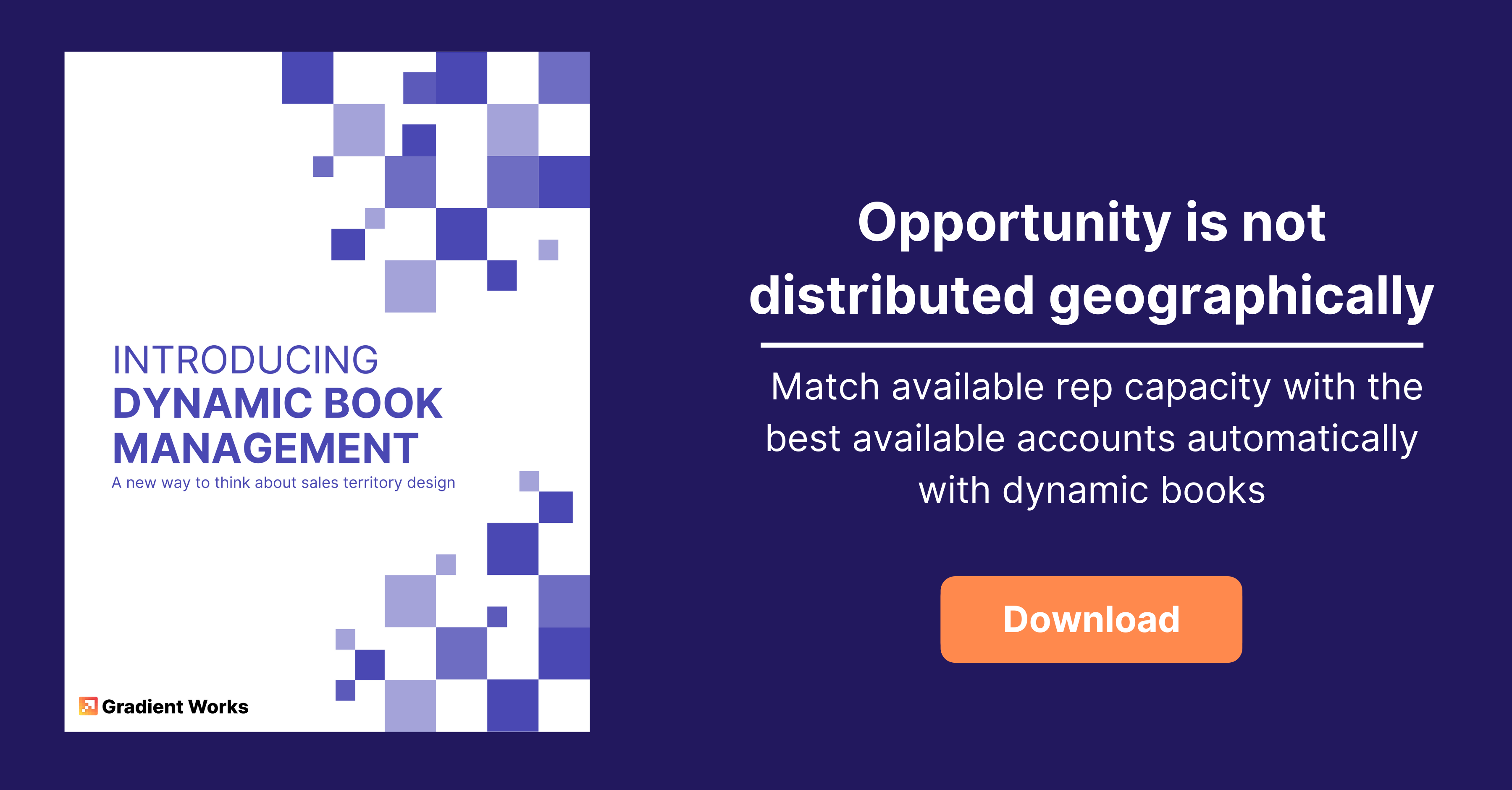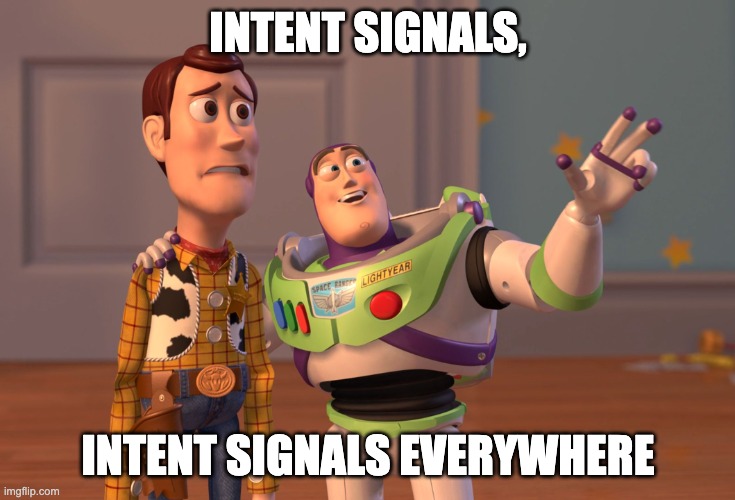Every company goes through an ICP exercise to identify the ideal customer for their business. For B2B organizations, those attributes provide information about the best companies to target as customers. And the individual components of an ICP definition, such as a company's firmographics, technographics, and behaviors, are incredibly valuable data to revenue teams.
Let’s dive into those specific data points, how to use them to forecast how a prospect will move through the customer lifecycle, and how operations can use intent information to improve Salesforce.
What is intent data?
First, a quick clarification between intent data and intent signals. Most see them as interchangeable. However, intent signals come from customer behavior. Think about signal as a verb; an intent signal is something that indicates a prospect might be interested in your product. You can learn more about what actions are included in intent signals.
Intent data, on the other hand, is contextual information like demographic, firmographic, and technographic information. To continue the metaphor, the adjectives that describe your target customers.
Many marketing and sales teams spend a lot of money on intent data providers like 6sense, Demandbase, etc. Those tools help companies identify important firmographic and technographic data that teams use for account scoring, prioritization, and personalization. Examples of firmographic data include:
- Industry
- Company size
- Location
- Ownership structure
- Company age
- Number of locations
If you’re unsure what attributes are relevant to your ICP, start by looking at your current customer base and look for similarities. Are they all software companies? Are they publicly held or have recently raised funds? In some cases, looking at the current customers doesn’t match the data points of your ICP. Be careful not to immediately alter your ICP based on the research, but it is possible that you have found an underserved segment for marketing and outbound sales teams to focus on.
Some ideal customer lists are too large and segmenting by the firmographic data still leaves you with too many accounts to cover. You need to narrow the list further using technographics.
Technographic data refers to information about the technology and digital tools that a company uses. Common technographic data include:
- Operating systems
- Web analytics tools
- Customer relationship management (CRM) software
- Marketing automation tools
- Content management systems (CMS)
- Cloud computing platforms
There is a lot of pressure across sales teams to find new account groups to build growth this year. Using technographic data creates highly personalized segments for sales and marketing. For example, a great mix of Gradient Works combines CRM and Cloud computing platforms. Companies using Salesforce+Intent data software like 6Sense, Bombora, etc. see the most benefit from dynamic book management. (If that describes you, see how it works with a product tour.)
While firmographic and technographic data starts with building an ICP, it’s even more valuable when using it to forecast and build sales and marketing strategies, like ABM, identify new business segments, and tailor messaging to get to a yes faster.
Using intent for forecasting
Forecasting is hard. But unlike meteorologists, if you get it wrong half the time, you likely won’t be employed very long. Don’t start researching the difference between cirrus and cumulonimbus clouds just yet. Intent data is a powerful tool that you can use to forecast sales. By analyzing the online behavior of potential customers and identifying patterns and trends, you can gain valuable insights that can be used to make more informed decisions. There are 4 ways to use intent to forecast throughout the sales cycle.
Intent data forecasts market trends
The online behavior of potential customers can identify emerging trends and patterns. This can help businesses to anticipate changes in the market and adjust their strategies accordingly. This data can come from a variety of sources, including social media, and can inform a number of decisions, including content creation, SEO, sales outreach personalization, and more.
Forecasting demand with intent data
The activities, intent signals, generated by potential customers can help businesses to anticipate a company's in-market and adjust their production or inventory levels accordingly. Do you need a 3rd party intent data provider to figure out a prospect's timing? Not necessarily. Using the analytics you have from your website can be an indicator of timing. For example, how many website visits have they had? Your marketing and website analytics can help you create an in-market timing signal to segment customers.
Score leads with intent
Once those segments are identified, analyze their online behavior, such as the content they consume and the topics they search for. Did a prospect also visit the pricing page or a product tour? Strategically, this level of scoring helps sales teams distribute and retrieve accounts based on their level of intent, allowing sales teams to focus on high-value prospects and improve their forecasting accuracy.
Forecasting sales pipeline
Finally, once a prospect has made contact with your company, you can use their firmographic and technographic data to identify key decision-makers and possible software integrations/security issues. Intent data can be used to forecast sales by identifying which accounts are most likely to close in a given period.
Better data hygiene with intent data
Data hygiene projects are sometimes the longest running, often the last priority, because of the sheer size, and let's face it, it’s terribly mundane. The data in your Salesforce has been gathered from various sources, and a lot of it is the subject of complaints. We call that “dusty data”. Interject intent data to help improve data hygiene in Salesforce.
Removing outdated or inaccurate data
According to Experian, human error influences over 60% of dirty data. Accounts are always changing, raising new funds, executing RIFs, and buying/changing technology. Intent data sources can be used to remove or auto-update outdated or inaccurate data from your Salesforce database, reducing clutter and improving data quality. Building regular updates into your Salesforce processes eliminates the amount of dirty data in your database and reduces human error.
Segment and prioritize accounts
Intent data eases the prioritization of contacts and accounts based on their fit for your business. Reps often spend too much time researching contacts and accounts. In fact, according to Inside Sales, sales reps can spend up to 40% of their time looking for somebody to call. Automating these changes to the account record can help you re-focus your sales and marketing efforts on high-fit accounts and/or remove those accounts from their books that no longer fit your product or service. Gradient Works customer, Omnipresent, took this challenge head-on and noted that having more clarity on their account books, reps were able to make more calls, touch more accounts, and created 16% more opportunities. Read their case study here.
Intent-based segmentation can highlight groups of accounts that need to be dusted off first, ensuring a more efficient process. Utilizing your intent data provider automates the exhaustive data hygiene projects, helping you to maintain a clean, up-to-date database and improve the efficiency and effectiveness of sales and marketing.
With the right use of intent data, you can make more informed decisions and see a significant improvement in sales and marketing outcomes, from anticipating demand, forecasting market trends and sales pipeline, segmenting accounts, and tailoring messaging. Additionally, intent data can help improve data hygiene in Salesforce by removing outdated or inaccurate data and prioritizing high-fit accounts for sales and marketing efforts.





